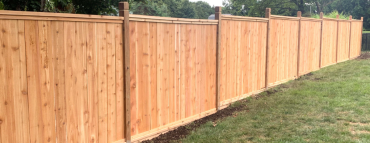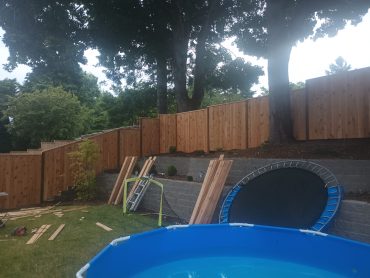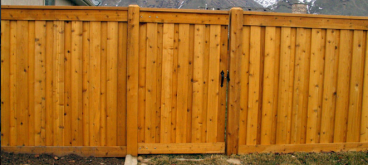Good Neighbor Fence: A Complete Guide for Portland, OR Residents
Are you tired of dealing with nosy neighbors or feeling like your backyard is on display for the whole neighborhood? Good neighbor fences are the solution you’ve been searching for. These fences not only provide privacy but also promote positive relationships with your neighbors.
Maintaining a harmonious connection with those living next door is essential, and a good neighbor fence helps achieve just that. With its sturdy construction and attractive design, this type of fencing not only enhances the aesthetics of your property but also ensures peace of mind.
From choosing the right materials to understanding what Oregon law says about who is responsible paying for a fence between neighbors, we’ll cover everything you need to know to make an informed decision. So why wait? Contact us today or give us a call at 971 236 8270 to transform your backyard into a private oasis without any presumption!
What is a Good Neighbor Fence?
A Good neighbor fences can take many forms, but generally, they are designed to be symmetrical and uniform from both sides. This means that both neighbors have an equal view of the fence, and neither neighbor has to look at the unsightly backside of the fence.
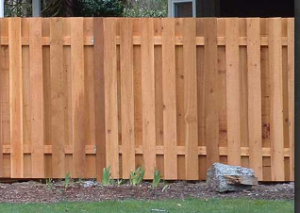
Neighbor Friendly Style Fence
Picture this: a fence that not only enhances the beauty of your property but also fosters an amicable relationship with your neighbors. This is what we call a good neighbor fence. It’s a fence that is carefully crafted with durable and long-lasting materials, such as cedar or vinyl, and is designed to be aesthetically pleasing to the eye from both sides. No eyesores here! What’s more, the cost of building a good neighbor fence is often shared between both parties, cementing the bond of goodwill. When building any type of fence let’s not forget about the importance of proper permits and adherence to local building codes. So why not consider a good neighbor fence today? It’s the perfect way to enhance your property and cultivate positive relationships with those around you.
What is the Purpose of a Good Neighbor Fence?
The idea is to create a fence that does not create animosity or disagreements between neighbors, but rather is a mutually agreed-upon boundary marker that enhances the appearance of both properties.
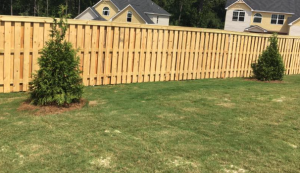
Different Styles and Designs of Good Neighbor Fences
A good neighbor fence can be an excellent choice. These fences not only provide privacy and security but also add a touch of character to any property. With various styles and designs available, you can find the perfect option that suits your preferences and needs. Portland is known for having stylish architecture and adding a modern Good Neighbor Fence can enhance your homes curb appeal.
Popular Fence Styles
Vertical Picket Good Neighbor Fences:
One popular style of a good neighbor fence is the classic design with vertical pickets that alternate back and forth on both sides of the fence. This design not only adds visual interest, but also provides structural stability to the fence. The alternating pickets create a sense of rhythm and movement, making the fence more visually appealing. Additionally, this design allows for better airflow through the fence, which can be beneficial in areas with strong winds. The vertical pickets also make it easier for homeowners to maintain their fences, as they can easily access both sides for cleaning or repairs. Overall, a good neighbor fence with vertical pickets alternating back and forth is a great choice for those who value both aesthetics and functionality in their fencing options.
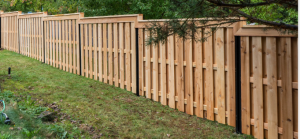
Horizontal Picket Good Neighbor Fences:
Horizontal picket good neighbor fences are like the cool kids of the fencing world! They bring a super trendy and modern vibe to any property. You know what’s so awesome about them? These fences have these special pickets that run horizontally, which means they go side to side instead of up and down like traditional fences. And get this – these pickets are evenly spaced 4 inches apart! That’s like having the perfect amount of breathing room for your fence. But wait, there’s more! These fences also have boards on both sides of the rails. So, no matter which way you look at it, you’re always getting a beautiful view. It’s like having two fences in one! Isn’t that just the coolest thing ever? With a horizontal picket good neighbor fence, you’ll be the envy of all your neighbors. Trust me, they’ll be asking where you got your super stylish fence from!

Modern Good Neighbor Fences:
A modern Good Neighbor Fence is a really cool type of fence that you can have in your backyard. It’s like a privacy fence, which means it helps to keep your yard private and separate from your neighbors’ yards. But what makes it even cooler is that it has these panels that are different from a regular privacy fence. Instead of just having one big panel after another, the Good Neighbor Fence has alternating panels. This means that some panels are on one side and some panels are on the other side. It’s kind of like a pattern, and it helps to break up the boring look of a regular privacy fence. So when you look at the Good Neighbor Fence from one side, you see one panel, and then when you look at it from the other side, you see a different panel. It’s a little bit like a puzzle! And not only does it look really nice, but it also gives you some extra privacy because it’s harder for people to see through the fence when there are different panels blocking their view. So if you want a fence that looks cool and gives you some extra privacy, the Good Neighbor Fence is definitely something to consider for your backyard!
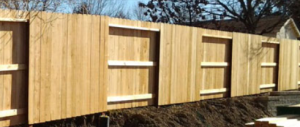
Various Design Options
Good neighbor fences come with numerous design options that add personality to your property:
-
Decorative Elements: From intricate patterns carved into wooden boards to ornamental caps on fence posts, there are endless possibilities to enhance the visual appeal of your good neighbor fence.
-
Architectural Complement: Consider how different styles can complement the architectural style of your home or landscape features such as gardens or pathways.
-
Color Choices: Depending on the material used for construction (wood or vinyl), you have the freedom to select colors that blend harmoniously with your surroundings.
Choosing the Right Style
Selecting a style for your good neighbor fence involves considering both aesthetics and functionality:
-
Aesthetic Preferences: Think about the overall look you want to achieve. Do you prefer a traditional, rustic, or modern appearance? Take into account the architectural style of your home and any existing outdoor elements.
-
Functional Needs: Determine the primary purpose of the fence. Are you looking for privacy, security, or a combination of both? Consider factors such as height, material durability, and maintenance requirements.
Remember that consulting with professionals like Superior Fence Services can provide valuable insights and guidance tailored to your specific needs.
Different Types of Good Neighbor Fences
There are several types available that offer different benefits and suit various preferences.
Common Materials Used for Good Neighbor Fences
-
Wood: Wood is a popular choice for good neighbor fences due to its natural aesthetic appeal. It can be easily customized to fit any style or design preference. However, wood requires regular maintenance such as staining or painting to protect it from weathering and rotting.
-
Vinyl: Vinyl fences have gained popularity in recent years due to their low maintenance requirements. They are resistant to rotting, warping, and fading, making them an excellent long-term investment. Vinyl fences come in various colors and styles, providing homeowners with flexibility in design.
-
Metal: Metal fences offer durability and security while requiring minimal upkeep. Aluminum and wrought iron are commonly used metals for good neighbor fences. Aluminum is lightweight yet sturdy, making it ideal for residential purposes. On the other hand, wrought iron provides a classic look but may require periodic repainting to prevent rust.
-
Composite Materials: Composite materials combine the best features of different materials such as wood fibers and recycled plastics. These fences mimic the appearance of wood while offering increased durability and resistance to weather conditions. Composite fences generally require less maintenance than traditional wood options.
Comparison of Durability, Maintenance Requirements, and Cost-Effectiveness
Each material type has its own advantages Maintenance requirements, and cost-effectiveness:
-
Wood fences provide a timeless look but may require more frequent repairs compared to other materials.
-
Vinyl fences are highly durable with minimal maintenance needs over time.
-
Metal fences offer superior strength but may need occasional touch-ups due to rust.
-
Composite materials provide a balance between durability and low maintenance, making them a cost-effective option in the long run.
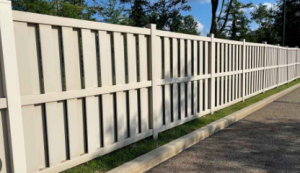
Specific Types of Good Neighbor Fences
-
Split Rail Fences: Split rail fences are a rustic option that adds charm to any property. They consist of wooden posts and horizontal rails, creating an open yet secure boundary. This type of fence is often used in rural areas or for decorative purposes.
-
Chain-Link Fences: Chain-link fences are known for their affordability and versatility. They are made from interwoven metal wires, providing security without obstructing the view. Chain-link fences are commonly used in residential areas where visibility is desired.
Considerations when Selecting a Type
When choosing a good neighbor fence type, it’s essential to consider factors such as climate and desired level of privacy:
-
Climate: If you live in an area with extreme weather conditions, selecting a material that can withstand these elements is crucial.
-
Privacy: Determine how much privacy you require. Some materials offer more coverage than others.
By understanding the different types of good neighbor fences available, homeowners can make informed decisions based on their preferences and specific needs. Whether it’s the timeless appeal of wood, the low maintenance of vinyl, or the durability of metal or composite materials, there is a perfect fence type for every homeowner’s taste and budget.
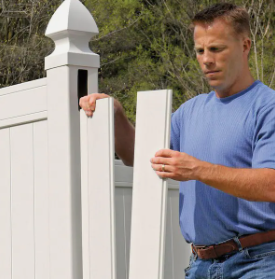
Selecting the Right Materials for Your Good Neighbor Fence
There are several factors you need to consider. From budget constraints to desired lifespan, selecting the right materials is crucial for a successful fencing project.
Factors to Consider
Before diving into the various material options available, it’s important to assess your specific fencing needs. Consider your budget, as certain materials may come at a higher cost than others. Think about how long you want your fence to last. Some materials require necessary replacement sooner than others.
Pros and Cons of Different Material Options
-
Wood:
-
Pros: Wooden fences offer a classic and natural look that complements various architectural styles. They can be customized according to your preferences.
-
Cons: Wood requires regular maintenance such as staining or painting. It is also susceptible to rotting, warping, or insect damage over time.
-
-
Vinyl:
-
Pros: Vinyl fences are known for their durability and low maintenance requirements. They are resistant to moisture, fading, or cracking.
-
Cons: While vinyl fences offer longevity, they might not provide the same aesthetic appeal as wooden fences.
-
-
Aluminum:
-
Pros: Aluminum fences are lightweight yet sturdy, making them suitable for both residential and commercial properties. They are resistant to rust and require minimal upkeep.
-
Cons: These fences may lack privacy due to their open design.
-
Evaluating Quality and Sustainability Aspects
When selecting materials for your good neighbor fence, it’s essential to evaluate their quality and sustainability aspects:
-
Quality: Look for reputable companies that offer high-quality fencing solutions backed by excellent customer reviews.
-
Sustainability: Consider eco-friendly options if environmental responsibility is a priority for you.
Recommendations Based on Specific Needs
-
Weather Resistance:
-
If you live in an area with harsh weather conditions, consider materials like vinyl or aluminum that are resistant to moisture, rot, or rust.
-
-
Low Maintenance:
-
Vinyl fences require minimal maintenance, making them an ideal choice for those looking for a hassle-free option.
-
-
Customization:
-
Wooden fences can be customized to suit your specific design preferences, allowing you to create a unique and personalized look.
-
Benefits of a Good Neighbor Style Fencing
There are several benefits to building a good neighbor fence:
- Aesthetically pleasing: A good neighbor fence is designed to look good from both sides, creating a cohesive look that enhances the appearance of both properties.
- Shared costs: Since both neighbors benefit from the fence, it’s common for the cost of building and maintaining the fence to be shared between the two parties.
- Improved relationships: By working together to build the fence, neighbors can establish a sense of camaraderie and goodwill, which can help foster a positive relationship.
- Increased privacy: A good neighbor fence can provide increased privacy and security for both properties, creating a more comfortable and enjoyable living space.
- Reduced conflicts: By establishing a clear boundary between the properties, a good neighbor fence can help reduce conflicts over property lines and other issues.
- Long-lasting: A well-built good neighbor fence can be durable and long-lasting, providing years of use and enjoyment for both neighbors.
Overall, a good neighbor fence is a great way to enhance the appearance of your property, foster positive relationships with your neighbors, and create a comfortable and enjoyable living space.
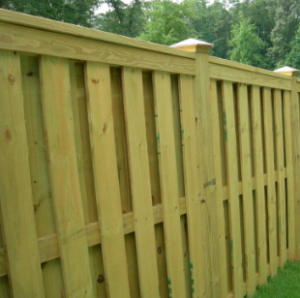
Overview of Good Neighbor Fence Laws in Portland, OR
Local Regulations for Fence Height and Placement
In Portland, Oregon, there are specific regulations that govern the height and placement of fences. These regulations ensure that fences do not obstruct views or create safety hazards for pedestrians and vehicles.
According to local laws, the maximum height allowed for a fence in most residential areas is six feet. However, if your property is located on a corner lot, the height restriction may be reduced to three and a half feet within certain distance from the street intersection. It’s important to note that these rules may vary depending on your specific neighborhood zoning.
You must build it within your property lines. It should not encroach onto neighboring properties or public spaces such as sidewalks. This ensures that each property owner maintains their own space while respecting the boundaries of others.
Obtaining Permits for Building a Fence
Before constructing a fence in Portland, you need to obtain the necessary permits from the city’s Bureau of Development Services (BDS). The purpose of these permits is to ensure that all fences comply with local regulations and building codes.
To apply for a fence permit, you’ll need to provide detailed plans specifying the dimensions and materials used in your proposed fence. Along with your application, you may also be required to pay a fee depending on the size and complexity of your project.
Once approved, you can proceed with building your fence according to the specifications outlined in your permit. It’s crucial to follow these guidelines to avoid any potential legal issues down the line.
Property Line Disputes and Resolution
Property line disputes can arise when neighbors disagree about where exactly their respective properties begin and end. These disagreements often occur when one party believes that a neighbor’s fence has been built beyond their property boundary.
If you find yourself involved in such a dispute in Portland, it is recommended to first try resolving it amicably with your neighbor. Open communication and a willingness to compromise can go a long way in finding a mutually agreeable solution.
If an agreement cannot be reached, you may need to seek legal assistance. In such cases, it is advisable to consult with a real estate attorney who specializes in property disputes. They can help you navigate the legal process and protect your rights.
Responsibilities and Rights of Neighbors
Both parties have certain responsibilities and rights. These responsibilities include maintaining the fence in good condition, sharing repair costs, and making decisions regarding any modifications or replacements.
It’s important for neighbors to communicate openly about any concerns or issues related to the shared fence. By working together, they can ensure that the fence remains in good shape and serves its intended purpose of providing privacy and security.
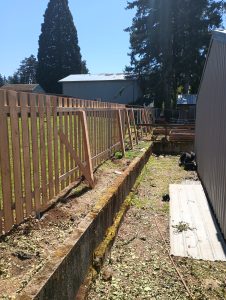
How To Build A Good Neighbor Fence
To build a good neighbor fence, follow these general steps:
- Discuss the fence project with your neighbor to establish mutual agreement on the design, materials, and cost-sharing.
- Determine the property line and obtain the necessary permits and approvals from your local authorities.
- Clear the fence line of any obstacles or debris, and mark the location of the fence posts.
- Dig holes for the fence posts using a post-hole digger, and ensure that they are deep enough to provide adequate stability for the fence.
- Insert the fence posts into the holes, making sure that they are plumb and level.
- Secure the posts in place with concrete or other suitable materials, and allow them to set according to the manufacturer’s instructions.
- Attach the horizontal rails to the posts, making sure that they are evenly spaced and level.
- Install the fence panels, using screws or other appropriate fasteners to attach them to the rails.
A Technique For Attaching Boards Good Neighbor Fence Style
When building a good neighbor fence, the fence boards need to be attached to the rails in a way that ensures that the fence looks good from both sides. Here are the general steps:
- Start by measuring the length of the fence panel, and cut the fence boards to the appropriate length.
- Begin attaching the fence boards to the rails, starting at one end of the panel. It’s important to ensure that the fence boards are level and plumb as you work your way along the panel.
- When attaching the fence boards, alternate the sides of the fence that you are nailing from. For example, if you are nailing the first fence board to the left side of the rails, then nail the next fence board to the right side of the rails.
- Make sure that the fence boards are evenly spaced and that the gaps between them are consistent.
- As you work your way down the panel, periodically check that the fence boards are still level and plumb. Adjust as necessary.
- When you reach the end of the panel, cut any excess material from the last fence board so that it lines up with the end of the rails.
- Repeat this process for each panel of the fence.
By following these steps, you can ensure that the fence boards are attached to the rails in a way that creates a consistent, aesthetically pleasing look from both sides of the fence.
9. Cut any excess material from the fence panels, ensuring that the fence line is straight and uniform.
10. Finish the fence with any desired decorative elements, such as trim or post caps.
Remember to work carefully and safely during the construction process, and consult with a professional if you are uncertain about any aspect of building the fence.
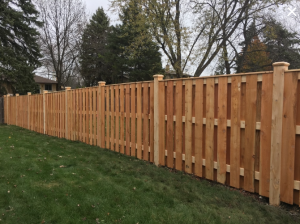
Tips for Installing a Good Neighbor Fence
Preparing the Site before Installation
Before diving into the installation process, it is crucial to prepare the site properly. Start by clearing any debris, rocks, or vegetation that may obstruct the fence’s path. This will ensure a smooth and hassle-free installation experience. Inspect the ground for any potential issues such as uneven terrain or buried utilities. Addressing these concerns beforehand will save you time and prevent future complications.
Accurately Measuring Property Lines
Avoiding encroachment issues is essential when installing a good neighbor fence. To ensure you stay within your property boundaries, take accurate measurements of your land. Utilize a reliable surveyor’s map or consult with a professional surveyor if needed. By doing so, you can avoid disputes with your neighbors and maintain good relations while enjoying your new fence.
Ensuring Proper Alignment, Stability, and Durability
To guarantee that your good neighbor fence stands strong for years to come, it is crucial to pay attention to alignment, stability, and durability during the installation process. Begin by setting sturdy posts at regular intervals along the boundary line using concrete or gravel for added stability. Make sure each post is plumb and level to maintain proper alignment throughout the fence’s length.
Next, attach horizontal rails securely between the posts using appropriate fasteners such as screws or nails designed for outdoor use. This step ensures that the panels remain firmly in place even during harsh weather conditions.
Consider choosing high-quality materials like pressure-treated wood or durable vinyl for enhanced longevity. Investing in superior fencing materials will save you from frequent repairs down the line and contribute to an aesthetically pleasing final result.
Using Appropriate Tools and Techniques
Streamlining the installation process requires utilizing suitable tools and techniques specific to fencing installation. Here are some recommendations:
-
Tools: Gather essential tools such as a measuring tape, level, post hole digger, circular saw, and a drill. Having the right tools at hand will make the process more efficient.
-
Techniques: Begin by marking the post hole locations using stakes or spray paint. Dig holes to the appropriate depth, ensuring they are wide enough to accommodate the posts. Use a level to ensure accurate alignment while setting the posts in place. When attaching panels, double-check their vertical and horizontal alignment for a polished finish.
By employing these tools and techniques, you can simplify the installation process and achieve professional-looking results.
Installing a good neighbor fence requires careful planning and execution. By following these tips on site preparation, accurate measurement of property lines, ensuring proper alignment, stability, and durability during installation, as well as utilizing appropriate tools and techniques; you’ll be well on your way to enjoying a beautiful and functional fence that enhances both your property’s aesthetics and privacy.
Common Mistakes to Avoid When Building a Good Neighbor Fence
Building a good neighbor fence is an excellent way to enhance privacy and establish boundaries between properties. However, there are several common mistakes that homeowners make during the construction process. By being aware of these errors and taking proactive measures, you can ensure a smooth and successful fence installation without any property line disputes or encroachment issues.
Identification of common errors made during fence construction
One of the most prevalent mistakes when building a good neighbor fence is failing to accurately identify the property lines. It’s crucial to consult your property survey or hire a professional surveyor to determine the exact boundaries before starting any construction. Relying solely on assumptions can lead to costly disputes with your neighbors down the line.
Another common error is neglecting proper communication with your neighbors. It’s essential to discuss your fencing plans with them in advance, ensuring that both parties are on the same page regarding design, materials, and shared costs. Open dialogue can prevent misunderstandings and foster good relationships within the community.
Tips on avoiding property line disputes or encroachment issues
To avoid property line disputes, it’s vital to respect the legal boundaries established by local regulations. Familiarize yourself with zoning laws, setback requirements, and height restrictions in your area before commencing construction. This knowledge will help you avoid potential legal consequences and maintain amicable relationships with neighboring property owners.
Furthermore, investing in a professional land surveyor can provide peace of mind when determining accurate property lines. Their expertise ensures that you won’t accidentally encroach upon your neighbor’s land or build too close to existing structures.
Advice on selecting suitable materials and following local regulations
Choosing appropriate materials for your good neighbor fence is crucial for its longevity and aesthetic appeal. Opt for durable options such as pressure-treated wood, vinyl, or metal that can withstand various weather conditions over time. Consider factors such as maintenance requirements, cost-effectiveness, and the overall style that complements your property.
Following local regulations is essential to avoid potential penalties or having to tear down non-compliant structures. Research the specific guidelines provided by your city or municipality regarding fence height, materials, and design restrictions. Adhering to these regulations will save you time, money, and potential legal headaches in the future.
Recommendations for seeking professional assistance when needed
While a DIY approach may seem tempting, it’s crucial to recognize when professional assistance is necessary. Complex terrain or large-scale projects may require specialized knowledge and equipment that only experienced contractors possess. Hiring professionals can ensure proper installation techniques and minimize the risk of errors that could compromise the integrity of your good neighbor fence.
Moreover, professional contractors often have insurance coverage that protects against accidental damage during construction. This added security provides peace of mind for both you and your neighbors.
Frequently Asked Questions about Good Neighbor Fences
1. Can I install any type of fence as long as it’s on my property?
No, Certain laws and regulations must be followed. These laws vary depending on where you live. It’s crucial to familiarize yourself with local ordinances before proceeding with any installation.
2. What is the best material for a good neighbor fence?
The choice of material depends on several factors such as budget, desired aesthetics, durability requirements, and maintenance preferences. Common materials used for good neighbor fences include wood, vinyl, and metal. Each material has its own advantages and considerations.
3. How high can I build my good neighbor fence?
Height regulations for fences also vary by location. It’s important to check with your local authorities to determine the maximum allowable height for your fence. Violating these regulations can result in fines or other penalties.
4. Do I need my neighbor’s permission to build a good neighbor fence?
While it’s not always required to obtain your neighbor’s permission, it is often recommended as a courtesy. Open communication and collaboration can help prevent potential conflicts and ensure that both parties are satisfied with the final outcome.
5. How do I maintain a good neighbor fence?
Regular maintenance involves inspecting for damages, cleaning debris, and applying protective coatings when necessary. Following manufacturer guidelines and addressing any issues promptly will help extend the lifespan of your fence.
Hire A professional!!
Though we don’t use these same techniques when building a Good Neighbor Fence because you would spend hours on end attaching fences boards, we at least wanted to provide the general concept for all you DYI enthusiasts. If the project seems to be just to far outside the scope of work your willing to do you can always hire a professional! At Good Neighbor Fence Company we hold true to our name and build beautiful neighbor friendly style fences!


